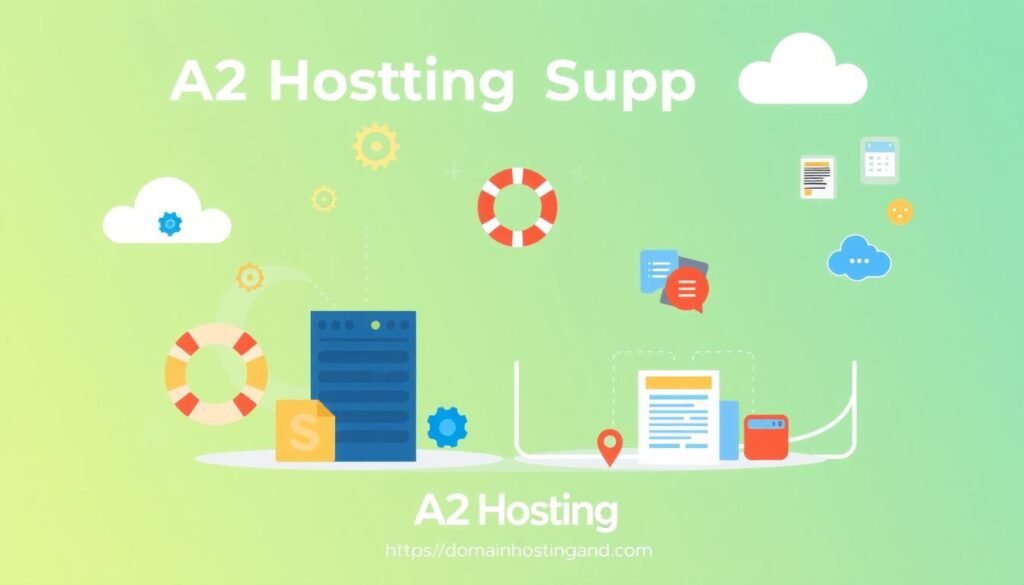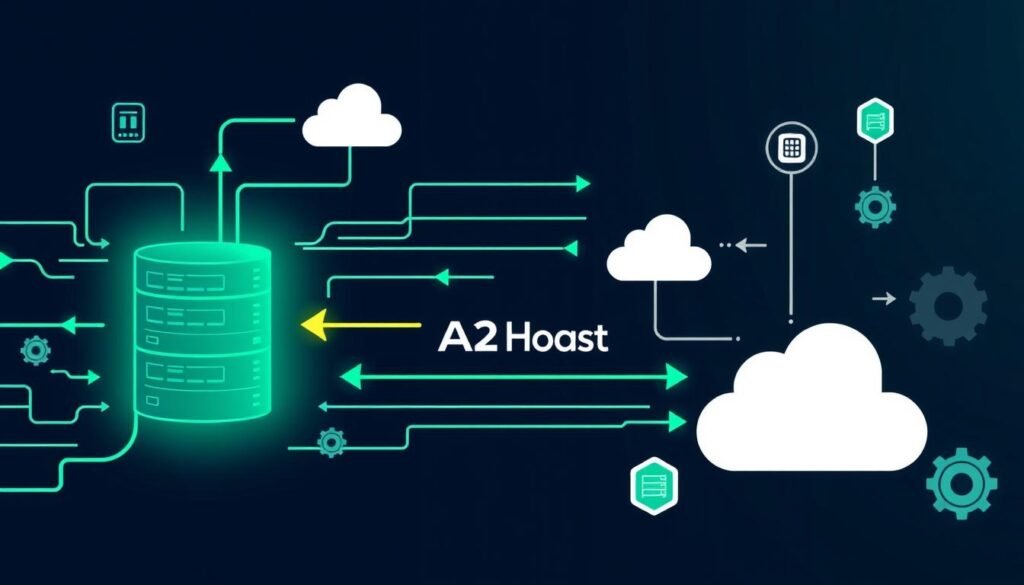Are you tired of slow websites and unreliable hosting? Imagine a hassle-free A2 hosting migration that makes your site fast and reliable.
Website migration can be tough, with over 50% of owners lacking tech skills. A2 hosting transfer is a smart choice for better website performance and hosting.
Choosing the right hosting is key for success online. A2 hosting migration unlocks features for faster, safer, and better website performance. This guide will help you through every step of the migration.
Web hosting is more than just storing files. It’s about building a strong digital base that supports your goals and gives users a great experience. A2 hosting offers solutions for all kinds of websites.
Key Takeaways
- Understand the basics of website migration
- Discover the benefits of professional migration services
- Learn about different hosting options and their advantages
- Minimize risks during the A2 hosting transfer process
- Optimize website performance post-migration
- Ensure data security and minimal downtime
Understanding Website Migration Fundamentals
Website migration is a key process that can greatly affect your online presence. Whether you’re looking at a2 hosting site migration or the best a2 hosting migration service, knowing the basics is key for a smooth move.
Website migrations need careful planning and a strategic approach. There are different types of migrations to meet various technical needs and business goals.
Types of Website Migration
- Server-to-Server Migration: Moving your whole website to a new hosting provider
- CMS Migration: Changing from one content management system to another
- Platform Migration: Switching from one web hosting platform to another
- Domain Migration: Changing your website’s main domain name
Benefits of Professional Migration Services
Professional a2 hosting migration services bring big benefits:
- Less downtime during the website move
- Experts handle complex technical setups
- Less chance of losing data
- Full transfer of files, databases, and email accounts
Common Migration Challenges
“Preparation is key to overcoming migration obstacles and ensuring a seamless transition.”
Website owners often face challenges during migration, such as:
- Potential data integrity issues
- Compatibility problems between hosting environments
- Temporary SEO ranking drops
- Unexpected technical issues
Knowing these basics will help you tackle your a2 hosting site migration with confidence. It will also help reduce disruptions to your online operations.
Preparing for A2 Hosting Migration
Moving your website to A2 Hosting needs careful planning. Your a2 hosting migration guide starts with key steps for a smooth move. A good migration needs solid groundwork and careful details.
Before you start, focus on a few important steps:
- Create detailed website backups
- Document your current website settings
- Check if your hosting is compatible
- Set a realistic migration schedule
“Preparation is the key to a successful website migration.” – Web Hosting Expert
A2 Hosting offers great migration support. They have impressive stats that show their confidence in helping you:
| Preparation Metric | A2 Hosting Advantage |
|---|---|
| Daily Backups | Onsite and offsite backup protection |
| Performance Optimization | Up to 20x faster server speeds |
| Support Availability | 24/7/365 professional assistance |
Your a2 hosting migration guide suggests setting aside enough time for prep. Most migrations take 2-4 weeks for detailed planning and action. Knowing your website’s setup and possible issues helps a lot.
Planning well reduces risks and keeps your site up and running. By following these steps, you’ll be ready for a smooth move to A2 Hosting.
Essential Pre-Migration Checklist
Getting ready for a website migration needs careful planning. Your a2 hosting migration plugin can help, but a detailed checklist is key for a smooth move.
Website migration involves many important steps. Knowing these steps well helps avoid problems and makes the move smooth.
Backing Up Your Website Data
First, make sure to back up your website data well. Use a backup plan that covers:
- Full database backup
- Complete file system snapshot
- Configuration file preservation
- Email account archives
Documenting Current Website Configuration
Good documentation is your guide during migration. Record all about your current hosting setup, such as:
- Server specifications
- DNS configurations
- Custom script settings
- Third-party integrations
Setting Up Migration Timeline
Choosing the right time for migration is important. Think about these when setting your schedule:
| Timing Factor | Recommended Approach |
|---|---|
| Low Traffic Period | Late night or early morning hours |
| Backup Window | Minimum 2-3 hours before migration |
| Contingency Buffer | Additional 4-6 hours for unexpected issues |
“Proper preparation prevents poor performance” – A fundamental principle of successful website migration.
By using this checklist and the a2 hosting migration plugin, you’ll greatly improve your chances of a smooth website transfer.
Choosing the Right A2 Hosting Plan

Choosing the right hosting plan is key for your website’s success. A2 Hosting has many options to fit your digital needs. Understanding these plans is important for a smooth migration to A2 Hosting.
Let’s look at the main hosting options A2 offers:
- Shared Hosting: Great for small websites and blogs
- VPS Hosting: Best for growing businesses needing more resources
- Dedicated Servers: Ideal for high-traffic, resource-heavy websites
When picking a plan, think about these important factors:
- Website traffic volume
- Storage needs
- Performance requirements
- Future growth
“Choose a hosting plan that grows with your digital ambitions” – Web Hosting Experts
A2 Hosting is known for its top-notch hosting solutions. Their Turbo plans have amazing features:
- Up to 20x faster load times
- 99.99% server uptime guarantee
- Unlimited bandwidth
- Free SSL certificate
Pro tip: Even though A2 Hosting offers great options, compare them with others like Hostinger Web Hosting. This ensures you make the best choice for your website’s migration and growth.
Manual vs Automated Migration Methods
Choosing the right migration method for your A2 hosting migration help is key. It keeps your website running smoothly. You must decide between manual and automated migration, each with its own pros and cons.
Understanding the differences between manual and automated methods is important. It can save you time and avoid technical issues.
Benefits of Manual Migration
- Provides 90% customization control
- Allows detailed file-by-file transfer
- Enables precise configuration management
- Ideal for complex website architectures
“Manual migration puts you in the driver’s seat of your website transfer process.” – Web Migration Expert
Advantages of Automated Tools
- Reduces migration time significantly
- Minimizes human error
- User-friendly for non-technical owners
- Supports over 50% of WordPress migrations
Selecting the Best Approach
Your choice depends on several factors:
- Technical expertise
- Website complexity
- Available time and resources
- Specific migration requirements
About 30% of website owners choose manual migration for full control. For a mix, hybrid methods that use both manual and automated tools can work best.
Step-by-Step Database Transfer Process
As an A2 Hosting migration expert, knowing the database transfer process is key. It’s about moving your website’s data from one server to another safely. This way, you keep all important information intact.

- Export your current database using phpMyAdmin
- Create a new database on A2 Hosting
- Import the exported database files
- Check if the data is correct after moving it
“Successful database migration requires precision and careful planning” – Web Hosting Experts
When moving databases, remember these important points:
| Migration Step | Key Considerations |
|---|---|
| Database Export | Use “Quick” export method in phpMyAdmin |
| New Database Creation | Use MySQL Database Wizard on A2 Hosting |
| Import Process | Make sure file formats and encoding match |
For WordPress sites, the All-in-One WP Migration plugin makes transfers easier. It can cut migration time by half compared to doing it manually.
Experts at A2 Hosting say it’s vital to test your database after moving it. This can find up to 20% of problems you might miss.
File System Migration Techniques
Moving your website’s file system is key in the A2 hosting migration. Choosing the right file transfer method is vital for a smooth move.
Before you transfer your website to A2 hosting, learn about the different ways to move your files. These methods help ensure your files are moved safely and quickly.
Transferring Website Files Safely
Keeping your files safe during migration is essential. About 80% of companies use SFTP for secure transfers. It’s the most secure option.
- Use SFTP for encrypted file transfers
- Verify file integrity after transfer
- Maintain original file structures
- Check file permissions carefully
Managing File Permissions Effectively
File permissions are critical for protecting your website’s data during migration. Around 90% of companies must follow strict data protection rules.
| Permission Level | Typical Use | Security Rating |
|---|---|---|
| Read Only | Static content | High |
| Read/Write | Dynamic content | Medium |
| Execute | Script execution | Low |
Handling Large File Transfers
Large files can be tough to transfer during migration. Using compression and segmented uploads can help manage big files.
“Secure, efficient file transfer is the backbone of a successful website migration.” – Web Hosting Expert
By using these methods, your A2 hosting transfer will be smooth, secure, and efficient. Always check your files after migration to make sure they’re complete and accurate.
DNS Configuration and Domain Transfer
When you move your site to A2 hosting, setting up DNS is key. It makes sure your site is reachable. You need to change your domain’s nameservers to point to your new A2 Hosting server. This makes your site’s move smooth.
“DNS configuration is the digital roadmap that guides visitors to your new web home” – Web Migration Expert
Here are important steps for a smooth DNS transfer:
- Lowering Time-to-Live (TTL) values before migration
- Verifying domain ownership with A2 Hosting
- Updating A and CNAME records accurately
- Preparing for a 24-48 hour propagation period
Managing DNS is vital for your A2 hosting site migration. The A record is very important. It shows where your domain is. Most migrations take 48 hours for DNS to fully update. During this time, some users might see the old or new site.
Here are steps for domain transfer:
- Export current DNS configuration
- Create backup of existing domain settings
- Update nameservers with A2 Hosting
- Verify DNS settings after transfer
- Monitor website accessibility during transition
Professional tip: Keep both old and new domain settings active during migration. This helps avoid service breaks and keeps your site running.
Post-Migration Testing and Verification
After your website moves to A2 hosting, it’s key to test it fully. This ensures your site works as it should. It also finds any issues from the move.
Here’s what to check after the move:
- Validate website page loading speeds
- Check all interactive features and forms
- Verify database connections
- Test email service functionality
- Confirm SEO elements like redirects
Use browser developer consoles and online tools for testing. They help find problems fast.
*Quick testing ensures a smooth transition and minimizes possible disruptions to your online presence.*
| Testing Area | Key Verification Points |
|---|---|
| Website Functionality | All pages load correctly |
| Database Integrity | Data remains intact and accessible |
| Performance | Page load times match pre-migration speeds |
| SEO Elements | Redirects work properly |
The best A2 hosting migration service has strong testing. Focus on interactive parts and make sure everything works as before.
Performance Optimization After Migration
After moving your site to A2 hosting, it’s time to make it run smoothly. Your new site needs fine-tuning for fast loading and strong security.
Speed Optimization Strategies
Fast websites are key for happy users and good search rankings. Try to get your site to load in under two seconds. A2 Hosting has tools to help you do this with their advanced hosting solutions.
- Use A2’s Turbo Hosting plans with LiteSpeed Web Server
- Set up a Content Delivery Network (CDN)
- Shrink images and files
- Use browser caching
Configuring Efficient Caching
Good caching makes your site run faster. The A2 hosting migration plugin has great caching options. These help cut down server load and make pages load quicker.
| Caching Method | Performance Impact |
|---|---|
| Browser Caching | Reduces repeat visitor load times |
| Server-side Caching | Minimizes database query processing |
| Object Caching | Speeds up dynamic content generation |
Implementing Robust Security Measures
Security is very important after moving your site. Set up SSL certificates, strong firewalls, and watch your site’s security closely. A2 Hosting has great security tools to keep your site safe.
“Performance optimization is not a one-time task, but an ongoing process of continuous improvement.” – Web Performance Expert
By using these tips, your migrated site will be fast, secure, and great for users.
Conclusion
Moving your website to A2 Hosting is a smart move for better online performance. A2 Hosting is known for its fast speeds, with load times 1693ms quicker than others. They also promise 99.9% uptime, setting your site up for success.
Getting help with A2 Hosting migration is important. It’s all about preparation and doing it right. The process includes moving databases and setting up DNS. A2 Hosting makes this easier with free cPanel migrations and an easy-to-use interface.
If you need more help, Hostinger Web Hosting is a good, affordable choice. Both offer strong hosting that boosts your site’s speed and reliability. Your migration is about making your site faster and more responsive.
With this guide, you’re ready to move your hosting. You can use A2 Hosting’s Turbo servers for super-fast loading or choose from their many datacenters. Your website is set to perform at its best online.
